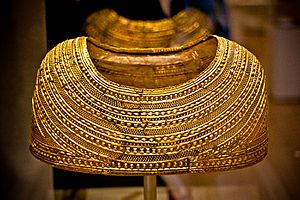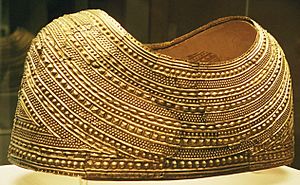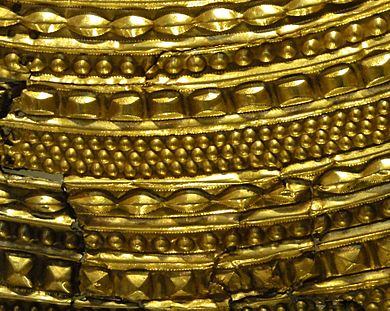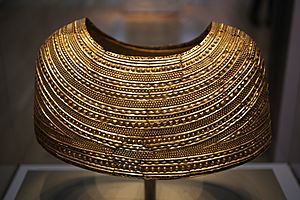Mold gold cape facts for kids
Quick facts for kids Mold gold cape |
|
|---|---|
| Clogyn Aur yr Wyddrug (Welsh) | |
|
The Mold gold cape in the British Museum
|
|
| Material | Gold |
| Created | 1900–1600 BCE |
| Discovered | 1833 Mold, Wales |
| Present location | British Museum |
The Mold gold cape (Welsh: Clogyn Aur yr Wyddgrug) is a special cape made from a thin sheet of gold. It comes from Wales and is very old, dating back to the Bronze Age (around 1900–1600 BCE). People believe it was worn for important ceremonies.
This amazing cape was found in a burial mound near Mold, Flintshire, in 1833. Today, you can see it at the British Museum in London, where it is usually on display.
Contents
Finding the Gold Cape
The gold cape was found by workers in 1833. They were either digging for gravel or quarrying for stone. The exact story of how they found it is a little unclear.
The cape was buried inside a Bronze Age burial mound. This mound was called Bryn yr Ellyllon, which means "Goblins' Hill". The gold cape was placed on the body of a person buried in a simple stone-lined grave. The skeleton was mostly broken, and the cape itself was badly crushed.
Originally, the cape had many amber beads, maybe 200 to 300 of them. But only one bead remains today. There were also pieces of rough cloth and 16 fragments of bronze sheet. These bronze pieces likely formed a backing for the gold, held together with small bronze rivets. Two gold 'straps' were also found nearby. An urn with burnt bones and ash was discovered close to the grave.
About the Mold Gold Cape
The cape is about 45.8 centimeters (18 inches) wide. It was made for someone with a very slender body, possibly a teenager. We don't know if the person buried with it was male or female. However, similar graves from that time suggest it might have been a woman. The cape shows signs of being worn and likely had a leather lining.
This cape is one of the most amazing examples of ancient gold work ever found. Its shape and design are unique. The cape is oval and would cover the shoulders, upper arms, and upper chest. It was higher at the back and lower in the front.
Wearing the cape would have made it hard to move your arms freely. Only the lower arms could be used. Because of this, it wasn't something worn every day. It was probably used for special ceremonies. It might have shown that the wearer was a very important person, perhaps a leader or someone with spiritual power.
Amazing Craftsmanship
The way the cape was made is truly exceptional. It was hammered out of a single piece of gold. This would have taken a lot of time and skill. Then, it was decorated with many raised patterns called repoussé concentric rings. These patterns almost completely cover the outer surface.
Some people think the patterns look like many strings of beads or folds of cloth. The high value of the gold and the amazing skill used to make it show that the cape came from a wealthy culture. Experts believe the people who made and owned the cape might have been connected to the Great Orme copper mine in north Wales. This was the largest copper mine in northwest Europe back then.
Cape Decorations and Patterns
There are small holes around the neck and bottom edges of the cape. These might have been for attaching a lining, perhaps made of leather. The cape has three main decorated areas:
- A band running around the bottom.
- A curved panel that dips at the neck and goes over the shoulders.
- Two matching panels for the upper arm areas.
Above the holes at the bottom, there are two raised ridges and a deep groove. Above the groove, there's a line of cone-shaped bumps. These bumps go all around the cape but split at the front to go up over the triangular panels on the upper arms. The bumps at the front are larger.
The front and back of the cape have detailed patterns of ridges and different types of bumps. The two triangular areas on the upper arms also have their own patterns. Many of the ridges and large bumps have tiny punched marks around them. These small details show the incredible skill of the ancient craftspeople.
Where the Cape is Displayed
When the cape was found, its backing had decayed, and it broke into many pieces. These pieces were spread out among different people. The British Museum bought most of the pieces in 1836. Over the years, more small fragments have been found and added back to the main part of the cape.
Small pieces of the actual cape are also on display in the museum at the Daniel Owen Centre in Mold.
Later, experts carefully studied and restored the cape. They realized its full shape. At one point, people thought it was a chest ornament for a horse! The cape is now mounted on cloth for display.
The Mold gold cape was chosen as one of the top British archaeological finds. It was featured in the BBC Television documentary Our Top Ten Treasures in 2003. It was also part of the BBC Radio 4 series A History of the World in 100 Objects in 2010.
The cape has also been temporarily displayed in Wales. It was at the National Museum of Wales in Cardiff and then in Wrexham in 2013.
Calls for the Cape to Return to Wales
Many people, including politicians in Wales, have asked for the Mold gold cape to be returned to a museum in Wales. They believe it should be displayed closer to where it was found.
In 2002, Alison Halford, a Welsh politician, asked the British Museum to return the cape to a museum in north Wales. She said that if there was a safe museum in north Wales, they would have a good reason to ask for its return. In 2011, other groups and politicians, like Elfyn Llwyd, also supported these calls. Llwyd said the cape is part of Wales's "collective memory" and should be returned.
In 2013, the cape was loaned to Wales for a short time. A local tourism leader was happy it returned temporarily but hoped a new local museum could house it permanently in the future. In 2018, another Welsh politician, Hannah Blythyn, again asked for its return. She raised the issue in the Welsh Assembly. In 2022, a former librarian, Andrew Green, also called for the British Museum to return artifacts, including the cape, to Wales.
See also
 In Spanish: Capa de oro de Mold para niños
In Spanish: Capa de oro de Mold para niños
- Golden hat
- Nebra skydisk
- Shropshire bulla
- Berliner Goldhut





